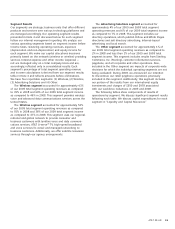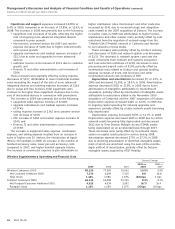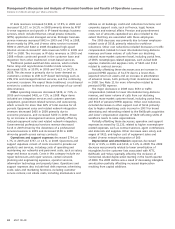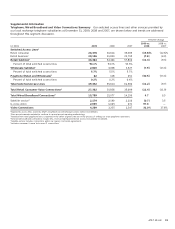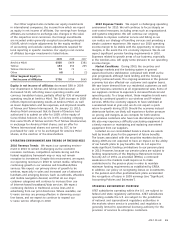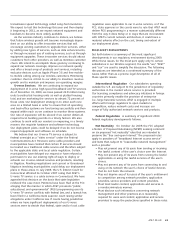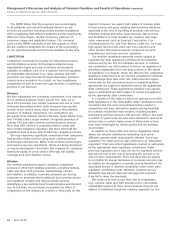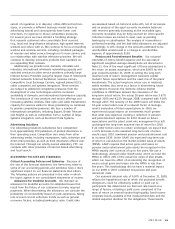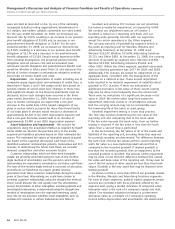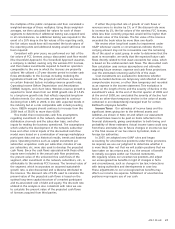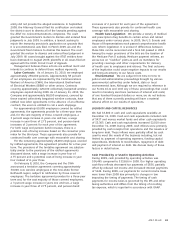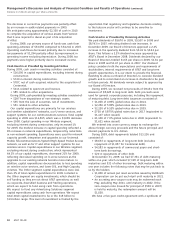AT&T Wireless 2009 Annual Report Download - page 44
Download and view the complete annual report
Please find page 44 of the 2009 AT&T Wireless annual report below. You can navigate through the pages in the report by either clicking on the pages listed below, or by using the keyword search tool below to find specific information within the annual report.
Management’s Discussion and Analysis of Financial Condition and Results of Operations (continued)
Dollars in millions except per share amounts
42 AT&T 09 AR
and has begun investigating how to develop policies to
promote that goal. While wireless communications providers’
prices and service offerings are generally not subject to state
regulation, an increasing number of states are attempting to
regulate or legislate various aspects of wireless services, such
as in the area of consumer protection.
AT&T has previously noted that the broadband marketplace
is robustly competitive and that we do not block consumers
from accessing the lawful Internet sites of their choice.
We therefore believe that prescriptive “net neutrality” rules
are not only unnecessary but also counterproductive to the
extent they would restrict broadband Internet access providers
from developing innovative new services for consumers
and/or content and application providers. Nor do we believe
that wireless providers should be prohibited from entering into
exclusive arrangements with handset manufacturers or that
government should regulate wireless early termination fees
as is currently being proposed. It is widely recognized that
the wireless industry in the United States is characterized by
innovation, differentiation, declining prices and extensive
competition among handset manufac turers, service providers
and applications. For this reason, additional broadband
regulation and new wireless requirements are unwarranted.
Expected Growth Areas
We expect our wireless services and data wireline products to
remain the most significant portion of our business and have
also discussed trends affecting the segments in which we
report results for these products (see “Wireless Segment
Results” and “Wireline Segment Results”). Over the next few
years, we expect an increasing percentage of our growth to
come from: (1) our wireless service and (2) data/broadband,
through existing and new services. We expect that our previous
acquisitions will enable us to strengthen the reach and
sophistication of our network facilities, increase our large-
business customer base and enhance the opportunity to
market wireless services to that customer base. Whether, or
the extent to which, growth in these areas will offset declines
in other areas of our business is not known.
Wireless Wireless is our fastest-growing revenue stream
and we expect to deliver continued revenue growth in the
coming years. We believe that we are in a growth period of
wireless data usage and that there are substantial
opportunities available for next-generation converged services
that combine wireless, broadband, voice and video.
Our Universal Mobile Telecommunications System/High-
Speed Downlink Packet Access 3G network technology covers
most major metropolitan areas of the U.S. This technology
provides superior speeds for data and video services, and it
offers operating efficiencies by using the same spectrum and
infrastructure for voice and data on an IP-based platform.
Our wireless networks also rely on digital transmission
techno logies known as GSM, General Packet Radio Services
and Enhanced Data Rates for GSM Evolution for data
communi cations. As of December 31, 2009, we served
85.1 million customers. We have also announced plans
to transition from 3G network technology to a higher
In the Telecommunications Act of 1996 (Telecom Act),
Congress established a national policy framework intended
to bring the benefits of competition and investment in
advanced telecommunications facilities and services to all
Americans by opening all telecommunications markets to
competition and reducing or eliminating regulatory burdens
that harm consumer welfare. However, since the Telecom Act
was passed, the Federal Communications Commission (FCC)
and some state regulatory commissions have maintained
certain regulatory requirements that were imposed decades
ago on our traditional wireline subsidiaries when they
operated as legal monopolies. Where appropriate, we are
pursuing additional legislative and regulatory measures to
reduce regulatory burdens that inhibit our ability to compete
more effectively and offer services wanted and needed by
our customers. For example, we are supporting regulatory
and legislative efforts that would offer new video entrants
a streamlined process for bringing new video services to
market and for offering more timely competition to traditional
cable television providers. With the advent of the Obama
Administration, the composition of the FCC has changed,
and the new Commission appears to be more open than the
prior Commission to maintaining or expanding regulatory
requirements on entities subject to its jurisdiction. In addition,
Congress, the President and the FCC all have declared a
national policy objective of ensuring that all Americans have
access to broadband technologies and services. To that end,
Congress has charged the FCC with developing a National
Broadband Plan and delivering that plan to Congress in early
2010. The Commission has issued dozens of notices seeking
comment on whether and how it should modify its rules and
policies on a host of issues, which would affect all segments
of the communications industry, to achieve universal access
to broadband. These issues include rules and policies relating
to universal service support, intercarrier compensation and
regulation of special access services, as well as a variety of
others that could have an impact on AT&T’s operations and
revenues. However, at this stage, it is too early to assess
what, if any, impact such changes could have on us.
In addition, states representing a majority of our local
service access lines have adopted legislation that enables
new video entrants to acquire a single statewide or state-
approved franchise (as opposed to the need to acquire
hundreds or even thousands of municipal-approved
franchises) to offer competitive video services. We also
are supporting efforts to update and improve regulatory
treatment for retail services. Passage of legislation is
uncertain and depends on many factors.
Our wireless operations operate in robust competitive
markets but are likewise subject to substantial governmental
regulation. Wireless communications providers must be
licensed by the FCC to provide communications services at
specified spectrum frequencies within specified geographic
areas and must comply with the rules and policies governing
the use of the spectrum as adopted by the FCC. The FCC has
recognized the importance of providing carriers with access
to adequate spectrum to permit continued wireless growth



